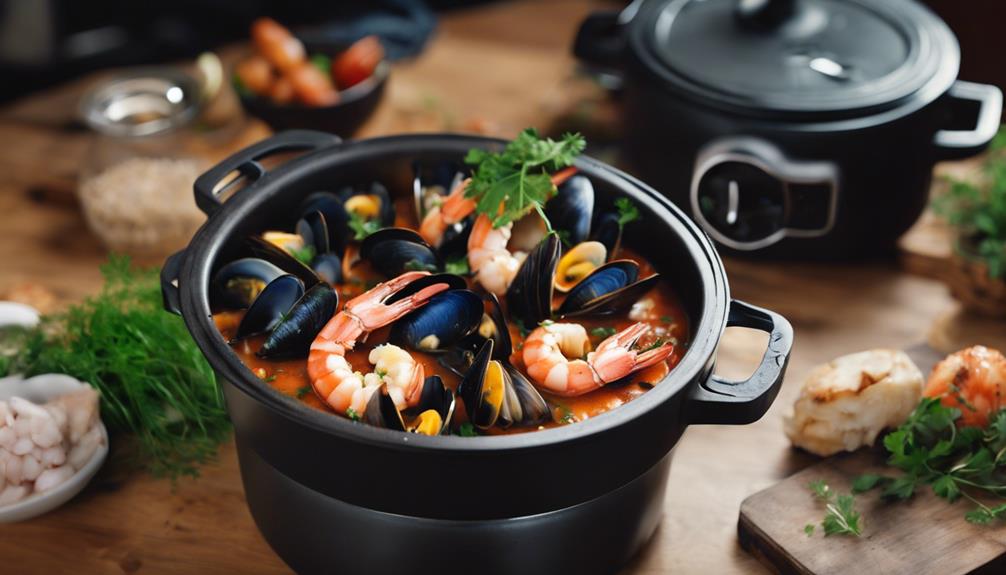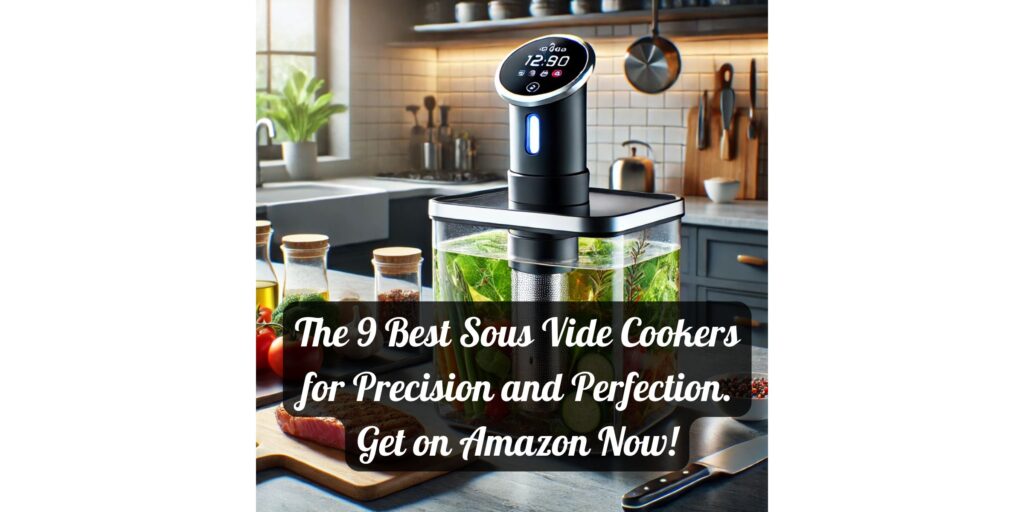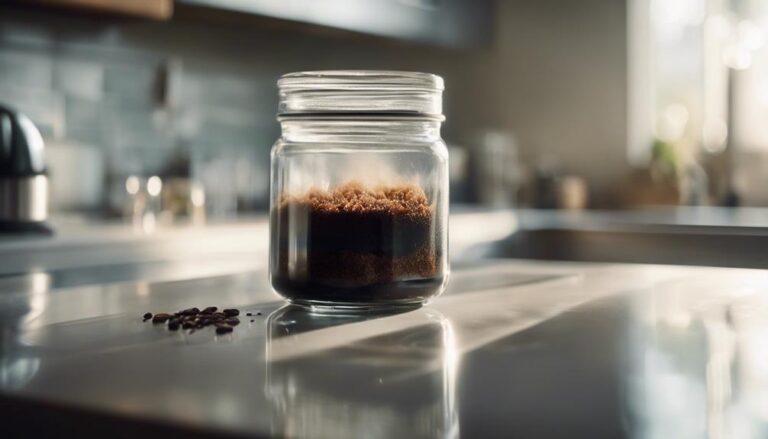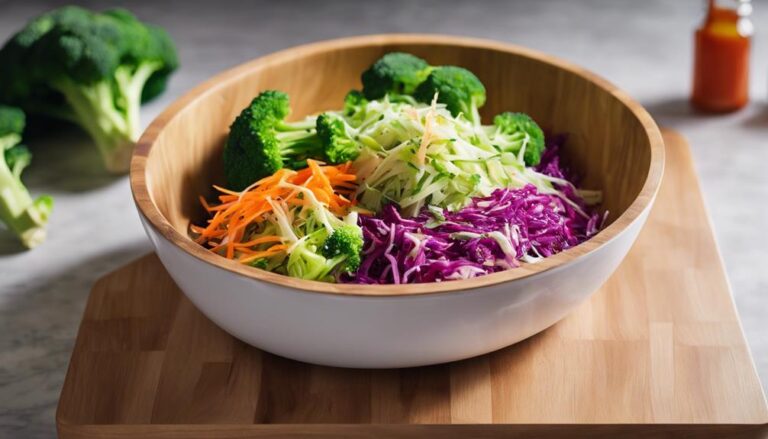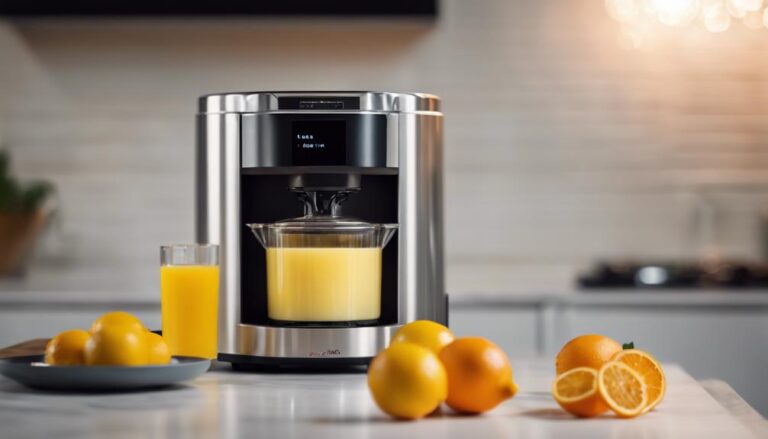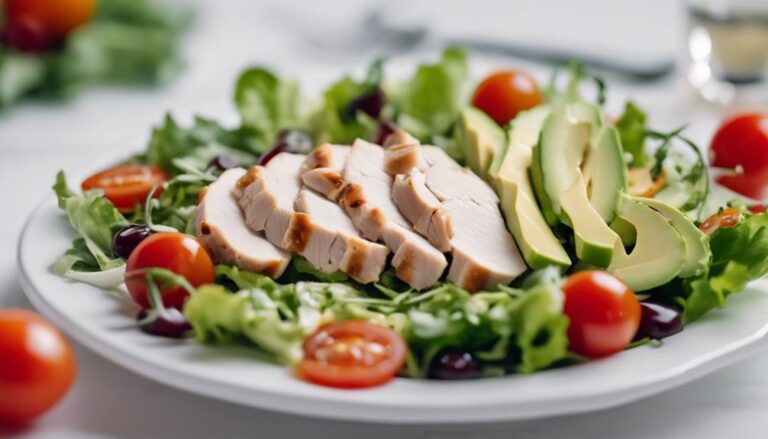Three-Point Sous Vide Seafood Stew
To whip up a Three-Point Sous Vide Seafood Stew, you'll start by vacuum-sealing scallops, shrimp, and white fish with chopped fennel and a touch of olive oil. Set your sous vide machine to a precise 140°F to guarantee the seafood cooks evenly, enhancing both flavor and tenderness. This method allows spices and clam juice to deeply infuse the seafood, creating layers of robust oceanic flavors. The gentle, controlled heat preserves the delicate texture of the seafood and prevents overcooking. With each ingredient harmoniously balanced, you'll savor a stew that's both succulent and aromatic. Explore further to uncover additional tips and tricks for perfecting your stew.
What You Will Learn Here
- Utilize a precision cooker set at 140°F for optimal cooking of delicate seafood.
- Vacuum seal seafood with spices to enhance flavor infusion during slow cooking.
- Include essential ingredients like scallops, shrimp, and white fish for a rich stew base.
- Add clam juice and chopped fennel for depth of flavor and a hint of sweetness.
- Cook sous vide for consistent heat distribution, preserving moisture and maximizing flavor.
Origins of Sous Vide Cooking

You might be intrigued to know that sous vide cooking, with its roots in 1970s France, was pioneered by chefs aiming to perfect the art of temperature precision.
This method involves vacuum-sealing your ingredients, a technique that not only enhances flavor but also guarantees that seafood, like in your stew, cooks evenly and retains its delicate textures.
As you explore modern culinary landscapes, you'll notice how sous vide has been embraced for its remarkable ability to intensify flavors and achieve an unmatched tenderness in a variety of dishes.
Sous Vide Historical Roots
Originating in France during the 1970s, sous vide cooking revolutionized professional kitchens by enabling chefs to cook food in airtight bags at meticulously controlled temperatures. This technique, which translates to 'under vacuum' and was pioneered by Georges Pralus, involves submerging vacuum-sealed ingredients in a water bath, ensuring precision in temperature and as a result, consistency in cooking.
The sous vide method particularly excels with seafood, preserving delicate flavors and textures that are often lost through conventional cooking methods. By maintaining lower temperatures over longer periods, you're able to achieve a level of tenderness and flavor infusion that's unparalleled, making every dish you serve not just a meal, but a finely tuned orchestration of taste and texture.
Key Technique Developments
In the 1960s, French chefs pioneered the use of vacuum-sealed bags to immerse and cook ingredients at precise temperatures, setting the stage for the development of sous vide techniques.
This meticulous water immersion technique revolutionized how delicate ingredients, particularly in seafood stew, could be handled. By sealing seafood in a bag, the natural flavors and juices are encapsulated, ensuring that every nuance of the sea is preserved and intensified during the slow cooking process.
The precise temperature control prevents overcooking, maintaining the seafood's tender texture. As you embrace this method, you'll find that your seafood stew retains a clarity of flavor and texture that traditional cooking methods simply can't match, elevating your culinary offerings to an art form.
Modern Culinary Adoption
Building on the vacuum-sealing innovations of the 1960s, sous vide cooking emerged in the 1970s in France, fundamentally reshaping culinary practices with its precision. By vacuum-sealing your seafood and other stew ingredients, you guarantee that flavors are locked in and evenly distributed throughout the cooking process.
This method, pioneered by chefs like Georges Pralus and Bruno Goussault, allows you to maintain a consistent temperature in the water bath, which is vital for achieving tender, perfectly cooked seafood. The technique's meticulous temperature control prevents overcooking, preserving the seafood's delicate texture and enhancing its natural flavors.
As you master sous vide, you'll find it indispensable for delivering impeccably consistent and flavorful seafood stews to those you serve.
Essential Seafood Stew Components
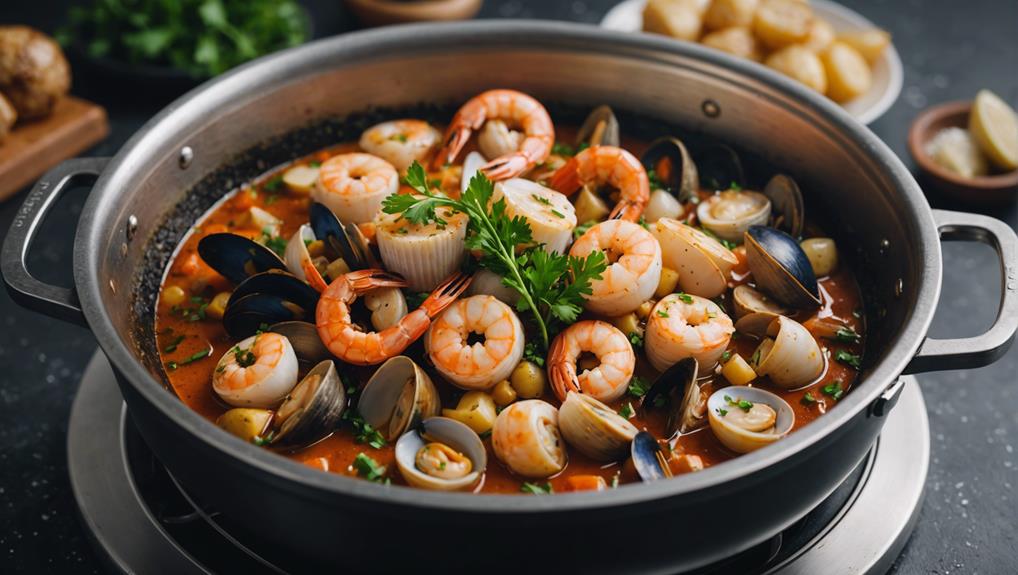
To create a rich and satisfying sous vide seafood stew, you'll need key ingredients like scallops, shrimp, and a white fish such as cod or tilapia. The selection of white fish is important, as it provides a tender, flaky texture that absorbs flavors beautifully.
Olive oil is essential for sautéing, lending a subtle richness that enhances the delicate flavors of the seafood. Adding a chopped fennel bulb not only imparts a slight anise-like sweetness but also contributes to the aromatic base that's fundamental in building layers of flavor.
When constructing your stew, consider the impact of each ingredient:
- Clam Juice: It's necessary for infusing the stew with a robust oceanic essence, thereby amplifying the overall seafood flavor.
- Aromatic Vegetables: Including fennel, carrot, and celery, these are sautéed in olive oil to create a flavorful foundation that complements the seafood.
- Herbs and Seasonings: Garlic, bay leaves, salt, and pepper are essential for enhancing and balancing the flavors, ensuring each spoonful is bursting with taste.
Trending Sous Vide Stew Recipes
You'll find the Lobster and Saffron Stew Recipe elevates traditional flavors by precisely controlling the cooking temperature, ensuring the lobster remains succulent while the saffron infuses its unique aroma throughout the dish.
The Salmon Miso Stew Recipe integrates miso paste to not only tenderize the salmon but also add a rich umami depth that complements the delicate fish perfectly.
Meanwhile, the Crab and Corn Stew Recipe pairs the sweetness of corn with the fresh, briny notes of crab, all harmonized under the gentle, even heat of the sous vide process.
Lobster and Saffron Stew Recipe
While exploring the art of sous vide, consider the Lobster and Saffron Stew, a recipe that masterfully combines the tenderness of perfectly cooked lobster with the rich, aromatic essence of saffron to elevate your culinary experience. This luxurious dish not only showcases the precision of sous vide cooking but also enhances the flavors, guaranteeing each bite is succulent and infused with gourmet flair.
- Perfectly Cooked Lobster: Sous vide guarantees the lobster remains tender, avoiding overcooking.
- Rich Aromatic Profile: Saffron adds a subtle complexity and a beautiful hue to the stew.
- Gourmet Dining Experience: Ideal for impressing guests with a sophisticated, flavor-packed meal.
Serve this exquisite lobster stew to delight and provide a memorable dining experience.
Salmon Miso Stew Recipe
How can you transform a simple salmon dish into a culinary masterpiece? Try the Salmon Miso Stew, a sous vide recipe that marries the delicate flavors of salmon with the deep umami of miso. Using the sous vide method, the salmon is cooked to perfection, its texture tender and its flavors deeply infused with the savory miso broth. This technique guarantees every bite is a harmonious blend of taste and texture.
- Precision Cooking: Sous vide provides exact temperature control for unmatched tenderness.
- Flavor Infusion: The slow cook time allows for a full flavor meld between the miso and salmon.
- Texture Perfection: Achieve a consistent, flake-apart texture without overcooking.
Serve this stew to impress at any dinner gathering, showcasing your dedication to both technique and taste.
Crab and Corn Stew Recipe
Immerse yourself in the rich flavors of our Crab and Corn Stew, where the sous vide method guarantees each morsel of crab is perfectly tender and the corn kernels burst with sweetness. This cooking technique allows for precise temperature control, ensuring your stew is cooked just right, preserving the delicate texture and enhancing the natural sweetness of the corn and the briny depth of the crab.
- Flavor Infusion: Sous vide cooking enhances the melding of sweet corn and rich crab flavors.
- Perfect Texture: Achieve impeccably tender crab without the risk of overcooking.
- Ease of Preparation: Minimal hands-on time means you can impress guests without the stress.
Serve this exquisite stew and savor the accolades from your delighted guests.
Sous Vide Technique Enhancements
When you harness the sous vide method, you're engaging in precision temperature control which guarantees your seafood stew ingredients cook evenly without ever reaching a boil. This technique maximizes flavor infusion, as the gentle heat allows spices and aromatics to permeate the seafood while maintaining its delicate texture.
Additionally, optimizing cooking time is essential; too short and the flavors won't meld, too long and the seafood could lose its succulent appeal.
Precision Temperature Control
By utilizing precision temperature control, sous vide cooking guarantees your seafood stew achieves the perfect level of tenderness and flavor with every preparation. When you set your Anova Sous Vide Precision Cooker to the ideal 140°F (60°C), you're ensuring that each piece of seafood is gently brought to its peak without the risk of overcooking.
This method not only preserves the delicate textures but also maximizes moisture retention, ensuring your stew is juicy and succulent. Precision temperature control is essential because it maintains a consistent heat throughout the cooking process, eliminating any hotspots that could potentially ruin your dish.
Trust in this technique to serve up a seafood stew that's consistently delightful, making every meal an occasion to remember.
Flavor Infusion Methods
To enhance your seafood stew's flavor profile, consider vacuum sealing your ingredients with select spices, herbs, and aromatics before sous vide cooking. This technique guarantees that every nuance of flavor is captured and intensified.
As you immerse your sealed pouch in the precisely controlled sous vide water bath, the flavors meld beautifully. The gentle, even heat allows the spices and herbs to infuse deeply into the seafood, creating layers of rich, robust taste.
This method not only preserves the natural moisture and tenderness of the seafood but also minimizes flavor loss. With each bite, your guests will experience the full, vibrant essence of each ingredient, making your sous vide seafood stew a memorable delight.
Cooking Time Optimization
After mastering the art of flavor infusion through vacuum sealing, let's focus on optimizing the cooking times to guarantee each type of seafood in your stew is perfectly tender and bursting with taste.
Sous vide enables precise temperature control, essential for the delicate nature of seafood. By setting exact temperatures, you make sure that each piece, whether it's firm fish or tender shellfish, reaches its ideal texture without the risk of overcooking. This method not only preserves the succulent moisture within the seafood but also enhances its natural flavors, making your stew richer and more enticing.
Tailor the cooking times for different seafood types to achieve a harmonious balance in your stew, bringing every spoonful to a state of perfection.
Final Thoughts
While exploring the depths of the Three-Point Sous Vide Seafood Stew, you'll discover that the precise cooking temperature of 140°F meticulously preserves the delicate texture and enhances the natural flavors of the seafood. The prowess of the Sous Vide Precision Cooker, a gem from Anova Applied Electronics, offers you an unparalleled advantage in achieving this perfection. The culinary experts at Feed Me Creative, Emily Farris and Jeff Akin, have harnessed this technology to make certain that each morsel of seafood – from the plump scallops to the tender cod – is cooked to just the right point of succulence.
As you investigate further, you'll appreciate the harmonious blend of aromatic vegetables and the robust backdrop of clam juice and white wine. The spicy green sauce, with its zestful mix of cilantro, garlic, and jalapeño, cuts through the richness, introducing a bright contrast that elevates the stew to a celebration of flavors.
Serving this stew, you become a channel of culinary artistry, bringing to the table not just a dish but an experience. It's a demonstration of how precision in cooking methodology can transform good ingredients into something sublime. The stew, balanced in its complexity, is both a comfort and a culinary adventure.
Frequently Asked Questions
Is Sous Vide Good for Seafood?
Yes, sous vide is great for seafood. You'll find flavor retention, texture control, and nutrient preservation enhanced, ensuring your dishes serve others with unmatched quality and precision-cooked perfection every time.
What Is the Best Temperature to Sous Vide Fish?
For peak fish texture control and flavor infusion, sous vide fish at 120°F to 140°F. This range guarantees ideal doneness levels, enhancing both taste and consistency for those you're serving.
Conclusion
As you wrap up your sous vide seafood stew, remember to gently release the vacuum-sealed bags to preserve the delicate textures of the seafood.
The precise temperature control guarantees each morsel is succulently cooked, enhancing the stew's deep, briny flavors.
Stirring in fresh herbs before serving adds a burst of brightness, elevating the rich, complex layers of your stew.
This technique not only honors the ingredients' integrity but transforms your seafood stew into an exquisite culinary masterpiece.
